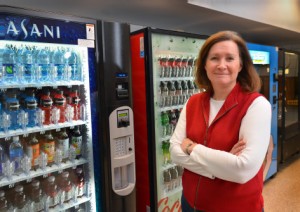
AMES, Iowa – The U.S. Department of Agriculture is proposing new federal rules for foods and beverages sold in school vending machines, stores or as ala carte items in the cafeteria. The rules aim to cut down on the amount of calories, sodium and sugar in products sold to students during school hours.
Ruth Litchfield, associate professor of food science and human nutrition at Iowa State University, said the USDA has not updated the rules for competitive foods in schools since the 1970s. Under the current federal rules, snack foods and drinks sold anywhere outside the lunchroom are not regulated. And those items sold in the lunchroom are only required to contain 5 percent of the daily value for one of eight nutrients, like protein, calcium or Vitamin C.
“That meant that you could sell some candy bars because they had more than 5 percent of the daily value for protein or calcium due to nuts or milk chocolate, but you couldn’t sell popcorn. That’s how outdated it was,” Litchfield said.
Under the proposed rules most candy bars would be banned. Only foods classified as a fruit, vegetable, protein, dairy product or whole grain are allowed, unless it contains 10 percent of the daily value for calcium, Vitamin D, potassium or fiber.
Improving student health is the motivating factor behind the proposed changes. Still, Litchfield expects resistance to the new rules because many schools generate significant revenue from vending machines and school stores. But those profits are not worth the cost to student health, she said.
“If we’re selling pop or candy bars or chips to fund school books or fund school field trips, I think we need to re-examine how we are funding our children’s education,” Litchfield said. “We’re setting students up for lifetime behaviors of using convenience foods as a mainstay in their diet and that’s a problem.”
Healthy Kids Act
According to a report from the Centers for Disease Control and Prevention, 39 states, including Iowa, already have a policy regarding snack foods and drinks sold in schools. Litchfield chaired the committee that created the Healthy Kids Act in Iowa, which went into effect in 2010.
“Iowa is now very well set to comply with these federal rules,” Litchfield said. “I think Iowa is going to be leaps and bounds ahead of the other states.”
The Iowa policy is based on recommendations from the Institute of Medicine, which the USDA also followed. Litchfield found one of the major differences between the Healthy Kids Act and the USDA rules is the requirements for beverages.
Federal limitations will not only be based on calories, but also portion size by grade level. For example, beverages available in middle schools and high schools must be sold in 12-ounce containers. However, in elementary schools beverages can only be 8 ounces. The rules do provide an exception at the high school level for 20-ounce drinks, as long as they are calorie-free. Litchfield is not certain if that exception would include low-calorie energy drinks.
Implementing the new rules
The proposed changes come after the USDA revamped the nutritional requirements for the government school lunch program. Litchfield said placing similar restrictions on snack foods and other items sold in schools will level the playing field.
“Now we have these healthier school meals, but we still have all these competitive foods in the building – the ala carte line, the school stores, the vending machines – that are still not promoting what we know are healthy, nutritious options for our kids,” Litchfield said.
The rules will not apply to items sold at concession stands for after-school events or treats brought from home in a child’s lunch or for a birthday party. The USDA is accepting public comment on the proposal for 60 days. The final rules must be published for a full school-year before they are enacted. Litchfield said the earliest would be fall 2014, but expects it may be fall 2015 before changes are made.
A full copy of the proposed rules can be found at: http://www.choosemyplate.gov/









